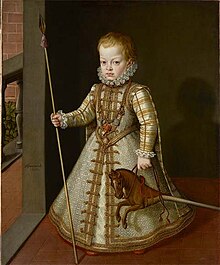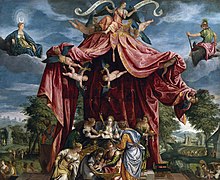| Diego | |||||
|---|---|---|---|---|---|
| Prince of Asturias and Portugal | |||||
 Portrait of Prince Diego aged 2 by Sánchez Coello, c. 1577 Portrait of Prince Diego aged 2 by Sánchez Coello, c. 1577 | |||||
| Born | 15 August 1575 Madrid, Crown of Castile, Spain | ||||
| Died | 21 November 1582(1582-11-21) (aged 7) Madrid, Crown of Castile, Spain | ||||
| Burial | El Escorial | ||||
| |||||
| House | Habsburg | ||||
| Father | Philip II of Spain | ||||
| Mother | Anna of Austria | ||||
Diego, Prince of Asturias and Portugal (Diego Felix; 15 August 1575 – 21 November 1582) was the fourth son of Philip II of Spain and his third son by his fourth wife, Anna of Austria.
Early life
At the time of his birth, Diego's elder brother, Prince Ferdinand, was still the heir-apparent. On the death of Ferdinand in 1578, Diego became heir-apparent to the throne. Diego also had another elder brother, Carlos Lorenzo, who died in infancy. His mother had just learned of the death of Carlos Lorenzo, and she was said to have suffered such a shock from word of his death that it caused her to go into premature labour, giving birth to Diego.

He was formally invested as Prince of Asturias on 1 March 1580 by the Courts in Madrid. The poet Cristóbal de Virués dedicated a sonnet to the new Prince, where he proposed that Diego follow the steps of his father.
In 1580, his father became king of Portugal as well, making Diego heir-apparent of that realm also. His mother, Anna, died during a trip to their new kingdom. Diego and his siblings remained in Madrid under the care of their half-sisters Isabella Clara Eugenia and Catherine Michelle. The letters of Philip II make clear that he was extremely proud of Diego: he wrote that his son had already learned the alphabet and dancing by the age of five. In a letter dated 1582 the king wrote to the Indian Viceroy Francisco de Mascarenhas commanding that he bring an elephant to the Prince of Asturias as a gift. Philip II taught his son the Portuguese language so that one day Diego could speak as king with his Portuguese subjects. In addition, Philip II planned to betroth Diego to one of the daughters of John, Duke of Braganza and Catherine of Portugal, thus strengthening his claim to the Portuguese throne.
Death
Diego never became king. In late 1582 he contracted smallpox and died at the age of 7. At his death, Philip II was inconsolable, for the only heir-apparent to the throne remaining was the small and sickly Infante Philip, who assumed the position of Prince of Asturias. The King gave orders that continuous prayers be said at the Church of Our Blessed Lady in Zaragoza for the health of the royal children remaining.
Diego's younger brother became King Philip III upon their father's death in 1598.
Ancestry
| Ancestors of Diego, Prince of Asturias | ||||||||||||||||||||||||||||||||||||||||||||||||||||||||||||||||||||||||||||||||||||||||||||||||||||||||||||||||||||||||||||||||||||||||||||||||||||||||||||||||||||||||||||||||||||||||||||||||||||||||||||||||||||||||||||||||||||||||||||||||||||||||||||||||||||||||||||||||||||||||||||||||||||||||||||||||||||||||||||||||||||||||||||||||||||||||||||||||||||||||||||||||||||||||||||||||||||||||||||||||||||||||||||||||||||||||||||||||||||||||||||||||||||||||||||||||||||||||||||||||||||||||||||||||||||||||||||||||||||||||||||||||||||||||||||||||||||||||||||||||||||||||||||||||||||||||||||||||
|---|---|---|---|---|---|---|---|---|---|---|---|---|---|---|---|---|---|---|---|---|---|---|---|---|---|---|---|---|---|---|---|---|---|---|---|---|---|---|---|---|---|---|---|---|---|---|---|---|---|---|---|---|---|---|---|---|---|---|---|---|---|---|---|---|---|---|---|---|---|---|---|---|---|---|---|---|---|---|---|---|---|---|---|---|---|---|---|---|---|---|---|---|---|---|---|---|---|---|---|---|---|---|---|---|---|---|---|---|---|---|---|---|---|---|---|---|---|---|---|---|---|---|---|---|---|---|---|---|---|---|---|---|---|---|---|---|---|---|---|---|---|---|---|---|---|---|---|---|---|---|---|---|---|---|---|---|---|---|---|---|---|---|---|---|---|---|---|---|---|---|---|---|---|---|---|---|---|---|---|---|---|---|---|---|---|---|---|---|---|---|---|---|---|---|---|---|---|---|---|---|---|---|---|---|---|---|---|---|---|---|---|---|---|---|---|---|---|---|---|---|---|---|---|---|---|---|---|---|---|---|---|---|---|---|---|---|---|---|---|---|---|---|---|---|---|---|---|---|---|---|---|---|---|---|---|---|---|---|---|---|---|---|---|---|---|---|---|---|---|---|---|---|---|---|---|---|---|---|---|---|---|---|---|---|---|---|---|---|---|---|---|---|---|---|---|---|---|---|---|---|---|---|---|---|---|---|---|---|---|---|---|---|---|---|---|---|---|---|---|---|---|---|---|---|---|---|---|---|---|---|---|---|---|---|---|---|---|---|---|---|---|---|---|---|---|---|---|---|---|---|---|---|---|---|---|---|---|---|---|---|---|---|---|---|---|---|---|---|---|---|---|---|---|---|---|---|---|---|---|---|---|---|---|---|---|---|---|---|---|---|---|---|---|---|---|---|---|---|---|---|---|---|---|---|---|---|---|---|---|---|---|---|---|---|---|---|---|---|---|---|---|---|---|---|---|---|---|---|---|---|---|---|---|---|---|---|---|---|---|---|---|---|---|---|---|---|---|---|---|---|---|---|---|---|---|---|---|---|---|---|---|---|---|---|---|---|---|---|---|---|---|---|---|---|---|---|---|---|---|---|---|---|---|---|---|---|---|---|---|---|---|---|---|---|---|---|---|---|---|---|---|---|---|---|---|---|---|---|---|---|---|---|---|---|---|---|---|---|---|---|---|---|---|---|---|---|---|---|---|---|---|---|---|---|---|---|---|---|---|---|---|---|---|---|---|---|---|---|---|---|---|---|---|---|---|---|---|---|---|---|---|---|---|---|---|---|---|---|---|---|---|---|---|---|---|---|---|---|---|---|---|---|---|---|---|---|---|---|---|---|---|---|
| ||||||||||||||||||||||||||||||||||||||||||||||||||||||||||||||||||||||||||||||||||||||||||||||||||||||||||||||||||||||||||||||||||||||||||||||||||||||||||||||||||||||||||||||||||||||||||||||||||||||||||||||||||||||||||||||||||||||||||||||||||||||||||||||||||||||||||||||||||||||||||||||||||||||||||||||||||||||||||||||||||||||||||||||||||||||||||||||||||||||||||||||||||||||||||||||||||||||||||||||||||||||||||||||||||||||||||||||||||||||||||||||||||||||||||||||||||||||||||||||||||||||||||||||||||||||||||||||||||||||||||||||||||||||||||||||||||||||||||||||||||||||||||||||||||||||||||||||||
- Friedrich Christoph Schlosser, Georg Ludwig Kriegk: World History for the German people, Vol. 13, Varrentrapp, 1852, p. 202.
- Freiherr von Münch: Book for Latin and English literature, Ferd. Dümmler, 1860, p.159.
| Diego, Prince of Asturias Spanish HabsburgsBorn: 15 August 1575 Died: 21 November 1582 | ||
| Spanish royalty | ||
|---|---|---|
| Preceded byFerdinand | Prince of Asturias 1578–1582 |
Succeeded byPhilip |
| Preceded byEmanuel | Prince of Portugal 1581–1582 | |
| Infantes of Spain | |
|---|---|
| The generations indicate descent from Carlos I, under whom the crowns of Castile and Aragon were united, forming the Kingdom of Spain. Previously, the title Infante had been largely used in the different realms. | |
| 1st generation | |
| 2nd generation | |
| 3rd generation | |
| 4th generation | |
| 5th generation |
|
| 6th generation |
|
| 7th generation | |
| 8th generation | |
| 9th generation | |
| 10th generation | |
| 11th generation | |
| 12th generation | |
| 13th generation | |
| 14th generation | |
| 15th generation | |
| 16th generation |
|
| |
| Austrian archdukes | |||||||
|---|---|---|---|---|---|---|---|
| Generations are numbered by male-line descent from the first archdukes. Later generations are included although Austrian titles of nobility were abolished in 1919. | |||||||
| 1st generation | |||||||
| 2nd generation | |||||||
| 3rd generation | |||||||
| 4th generation | |||||||
| 5th generation | |||||||
| 6th generation | |||||||
| 7th generation | |||||||
| 8th generation | |||||||
| 9th generation | |||||||
| 11th generation | |||||||
| 12th generation | |||||||
| 13th generation | |||||||
| 14th generation | |||||||
| 15th generation | |||||||
| 16th generation |
| ||||||
| 17th generation |
| ||||||
| 18th generation |
| ||||||
| 19th generation |
| ||||||
| |||||||
| Infantes of Portugal | |
|---|---|
| The generations indicate descent from Afonso I, and continues through the House of Aviz, the House of Habsburg through Infanta Isabel, Holy Roman Empress and Queen of Spain, and the House of Braganza through Infanta Catarina, Duchess of Braganza. | |
| 1st generation | |
| 2nd generation | |
| 3rd generation | |
| 4th generation | |
| 5th generation | |
| 6th generation | |
| 7th generation | |
| 8th generation | |
| 9th generation | |
| 10th generation | |
| 11th generation | |
| 12th generation | |
| 13th generation | |
| 14th generation | |
| 15th generation | |
| 16th generation | |
| 17th generation | |
| 18th generation |
|
| 19th generation | |
| 20th generation | |
| 21st generation | |
| 22nd generation | |
| 23rd generation | |
| 24th generation | |
| * also an infante of Castile and León, Aragon, Sicily and Naples, § also an infante of Spain and an archduke of Austria, # also an infante of Spain, ‡ also an imperial prince of Brazil, ¶ also a prince of Saxe-Coburg and Gotha, Duke in Saxony, ◙ also a prince of Braganza, ¤ title removed in 1920 as their parents' marriage was deemed undynastic, ƒ claimant infante | |
| Princes and Princesses of Asturias | ||
|---|---|---|
|  | |
| Princes and Princesses of Girona | ||
|---|---|---|
|  | |
- 1575 births
- 1582 deaths
- 16th-century House of Habsburg
- Princes of Asturias
- Dukes of Montblanc
- Princes of Portugal
- Spanish infantes
- Portuguese infantes
- Heirs apparent who never acceded
- Children of Philip II of Spain
- Burials in the Pantheon of Infantes at El Escorial
- Royalty who died as children
- Sons of kings
- Sons of dukes
- Sons of counts